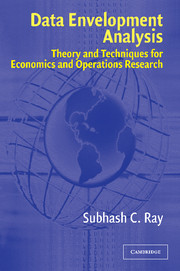Book contents
- Frontmatter
- Contents
- Preface
- 1 Introduction and Overview
- 2 Productivity Efficiency, and Data Envelopment Analysis
- 3 Variable Returns to Scale: Separating Technical and Scale Efficiencies
- 4 Extensions to the Basic DEA Models
- 5 Nonradial Models and Pareto–Koopmans Measures of Technical Efficiency
- 6 Efficiency Measurement without Convexity Assumption: Free Disposal Hull Analysis
- 7 Dealing with Slacks: Assurance Region/Cone Ratio Analysis, Weak Disposability, and Congestion
- 8 Efficiency of Merger and Breakup of Firms
- 9 Efficiency Analysis with Market Prices
- 10 Nonparametric Approaches in Production Economics
- 11 Measuring Total Productivity Change over Time
- 12 Stochastic Approaches to Data Envelopment Analysis
- 13 Looking Ahead
- References
- Index
11 - Measuring Total Productivity Change over Time
Published online by Cambridge University Press: 24 November 2009
- Frontmatter
- Contents
- Preface
- 1 Introduction and Overview
- 2 Productivity Efficiency, and Data Envelopment Analysis
- 3 Variable Returns to Scale: Separating Technical and Scale Efficiencies
- 4 Extensions to the Basic DEA Models
- 5 Nonradial Models and Pareto–Koopmans Measures of Technical Efficiency
- 6 Efficiency Measurement without Convexity Assumption: Free Disposal Hull Analysis
- 7 Dealing with Slacks: Assurance Region/Cone Ratio Analysis, Weak Disposability, and Congestion
- 8 Efficiency of Merger and Breakup of Firms
- 9 Efficiency Analysis with Market Prices
- 10 Nonparametric Approaches in Production Economics
- 11 Measuring Total Productivity Change over Time
- 12 Stochastic Approaches to Data Envelopment Analysis
- 13 Looking Ahead
- References
- Index
Summary
Introduction
Back in Chapter 2, quite early in this book, we distinguished between productivity and efficiency as two different measures of performance of a firm – the former descriptive and the latter normative. In all of the chapters in this book, we have so far dealt only with efficiency. Yet, in the macroeconomics literature as well as in the business economic press, there is a keen interest in variation in productivity across countries and over time. Unfortunately, increase in output per hour (or labor productivity), the most widely used measure, ignores differences in other inputs used and fails to measure Total Factor Productivity Growth (TFPG). To address this problem, one needs to construct measures of input and output changes that incorporate changes in all individual outputs and inputs. Two of the popular measures of total factor productivity (TFP) are the Tornqvist and the Fisher productivity indexes. Both use price information along with quantity data to construct quantity indexes of output and input. The ratio of the output and input quantity indexes is the TFP index. Both Tornqvist and Fisher indexes are descriptive measures of productivity change. Neither of the two measures requires any knowledge of the underlying production technology faced by the firm. By contrast, the Malmquist productivity index introduced by Caves, Christensen, and Diewert (CCD) (1982) is a normative measure that constructs a production frontier representing the technology and uses the corresponding distance functions evaluated at different input–output combinations for productivity comparison.
- Type
- Chapter
- Information
- Data Envelopment AnalysisTheory and Techniques for Economics and Operations Research, pp. 274 - 306Publisher: Cambridge University PressPrint publication year: 2004



